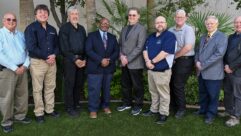Brett Moss is gear & technology editor.
We at Radio World hear a lot of talk about “corporate” radio, “cookie-cutter” radio, the “homogenization” of radio and the death of “community” radio. The mean big radio guys are always kicking the nice little radio guys around and stealing their lunch money.
Some of this can be dismissed as reflexive contrarian grumbling and the whining of people with an ax to grind or who think they should be running the corporate radio group or want someone else to pay for their own vanity radio station, though not all of it (and you know who you are).

Buc Fitch and Bill Rosenfeldt fire up the WOPG transmitter. More station pix are at pax-et-bonum-radio.org.
For people who complain about big radio, witness WOPG(FM).
This is a real live, honest-to-goodness new radio station that we learned about through our contributor Buc Fitch, who worked on the project.
It’s not a reformat. Not a resurrected call sign or acquired license. A new from-the-ground-up radio station.
Broadcasting loudly and proudly (up to 1.4 kW on 89.9) from the Albany, N.Y., area, the Catholic-formatted WOPG is the work of four people: Laura and Tom, Pat and Mike, who decided that maybe they could make a difference in their community.
All are recent retirees (nurse, engineer, school teacher and state government worker). With no previous radio experience whatsoever, they put together a charitable foundation and applied for a noncommercial education broadcast permit. Achieving that lofty goal they then proceeded to put together a radio broadcast facility, pretty much from scratch.
A fortuitous encounter with Stephen Gajdosik of the Catholic Radio Association guided the uninitiated students of the industry through the construction permit process (intimidating for radio industry people, much less newbies).
A second fortuitous encounter, this time with engineer Fitch, prevented the neophytes from being consumed by ravenous radio wolves hiding in the broadcast forest.
Money came from personal funds and donations through campaigns with local churches.
And then there was “sweat equity.” Lots of that.
Station ringleader Tom Threlkeld said: “We want to make WOPG more local with many volunteer voices offering content significant to the area. We really have a lot to learn.”
Real 1920s-style studio-in-the-attic-transmitter-in-the-chicken-coop radio? WOPG is all about that. The whole operation can be described generously as barebones. WOPG doesn’t do much live radio yet; that’s a little further along their learning curve. But they have begun to put together shows actually recorded at the station. Short shows. Very short shows.
Programming is mostly via satellite feed from the Catholic radio program distributor, EWTN. Getting a signal expeditiously onto the air was goal number 1. Next stop becomes recorded program generation.
Then maybe a morning zoo show? Maybe not. WPOG has modest goals at this point.
At “the studio,” located on the third floor of the St. Stanislaus School in Amsterdam, N.Y., they’re working with a Mackie mixer. The mics are from Marshall’s MXL division. Audio cards are from M-Audio. Off-the-shelf Dell computers run the automation. That automation system? Zara Studios – it’s a Spanish company, in case you didn’t know. I didn’t. Apparently the inexpensive system is quite popular in Latin and South America. Satellite comes through a Taylor Enterprises Traxis DBS 3800 receiver. They’re based somewhere on a mountaintop in Kentucky. I didn’t know that either.
Speaking of retirees, there is a CBS FM Volumax and a dbx 266XL compressor with second lives at WOPG.
Most of the equipment was donated, scrounged from lesser-known outlets, obtained cheaply using Buc’s connections or bought off of eBay and Craigslist. Not much was bought new and unused from a manufacturer.
By doing their homework, and with a little help from the Catholic Radio Association, the entrepreneurs located an old unused microwave tower in their vicinity that they then purchased for their own transmission use. That eventually entailed buying a new Propagation Systems directional antenna, which WOPG personnel personally transported from PSI (after testing, of course).
Threlkeld told me of their penny-aware ways, “New are EIA connectors for LDF7 coaxial cable, those are pricey …”
That’s how radio people have to think. Welcome to Radioland, Tom.
Got a radio facility project story to share? Tell me at [email protected].












